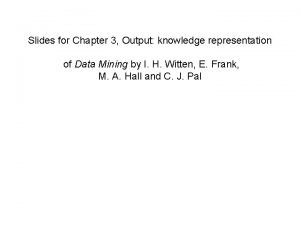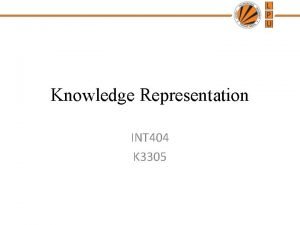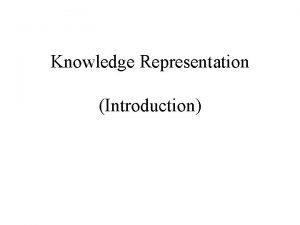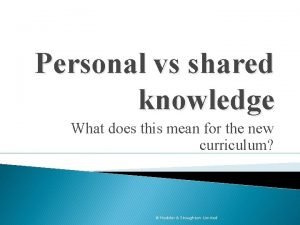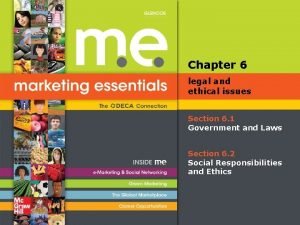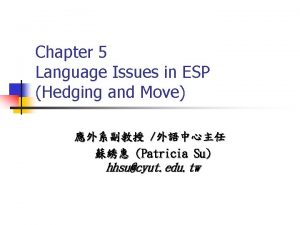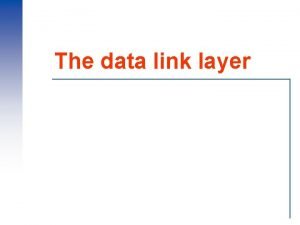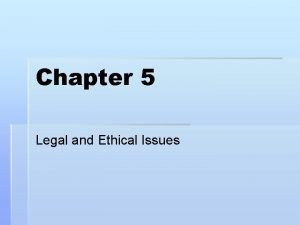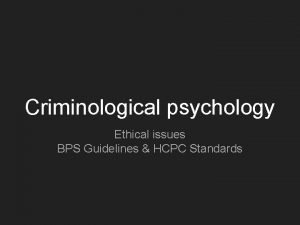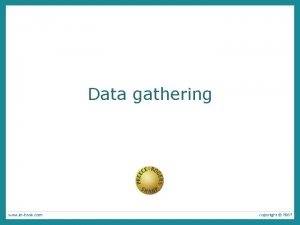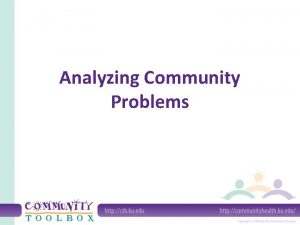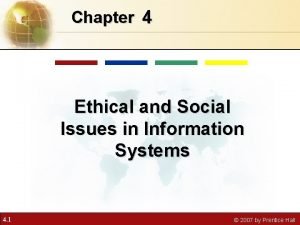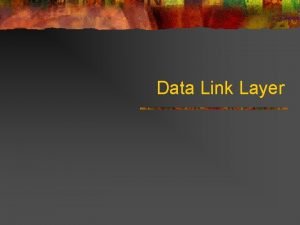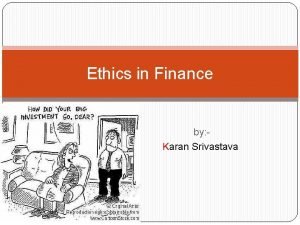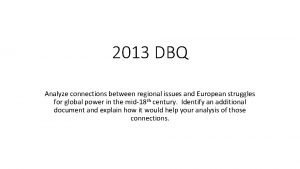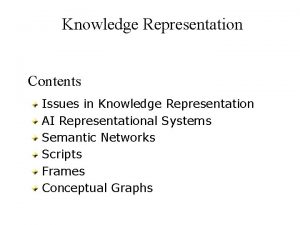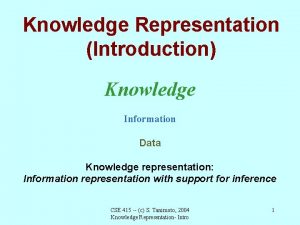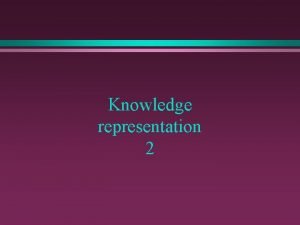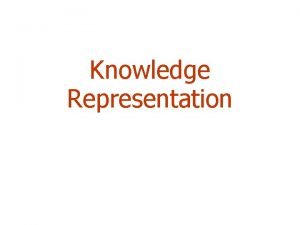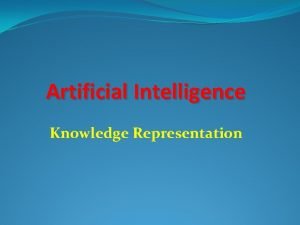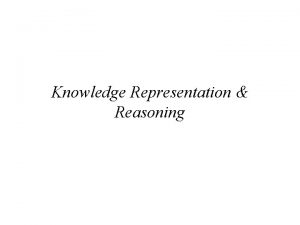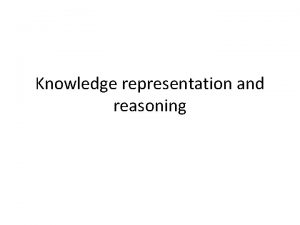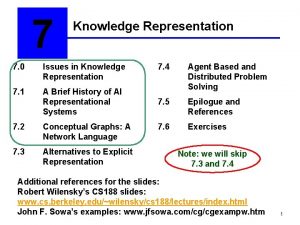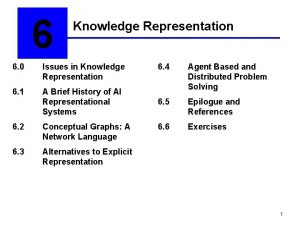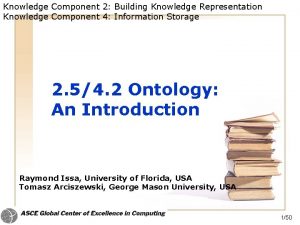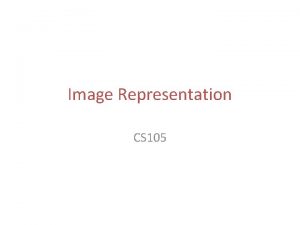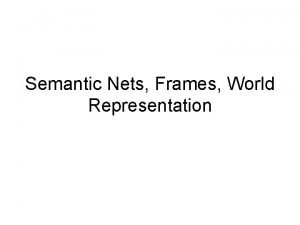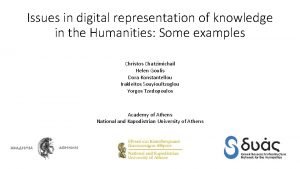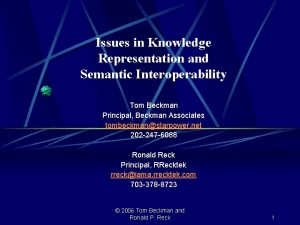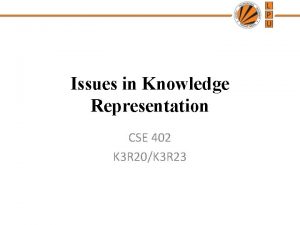Knowledge Representation 7 0 Issues in Knowledge Representation





























- Slides: 29

Knowledge Representation 7. 0 Issues in Knowledge Representation 7. 3 Alternatives to Explicit Representation 7. 1 A Brief History of AI Representational Systems 7. 4 Agent Based and Distributed Problem Solving 7. 2 Conceptual Graphs: A Network 7. 5 Epilogue and References Language 7. 6 Exercises George F Luger ARTIFICIAL INTELLIGENCE 6 th edition Structures and Strategies for Complex Problem Solving 1 Luger: Artificial Intelligence, 6 th edition. © Pearson Education Limited, 2009

Fig 7. 1 Semantic network developed by Collins and Quillian in their research on human information storage and response times (Harmon and King, 1985) 2 Luger: Artificial Intelligence, 6 th edition. © Pearson Education Limited, 2009

Fig 7. 2 Network representation of properties of snow and ice 3 Luger: Artificial Intelligence, 6 th edition. © Pearson Education Limited, 2009

Fig 7. 3 three planes representing three definitions of the word “plant” (Quillian, 1967). 4 Luger: Artificial Intelligence, 6 th edition. © Pearson Education Limited, 2009

Fig 7. 4 Intersection path between “cry” and “comfort” (Quillian 1967). 5 Luger: Artificial Intelligence, 6 th edition. © Pearson Education Limited, 2009

Fig 7. 5 Case frame representation of the sentence “Sarah fixed the chair with glue. ” 6 Luger: Artificial Intelligence, 6 th edition. © Pearson Education Limited, 2009

Conceptual dependency theory of four primitive conceptualizations 7 Luger: Artificial Intelligence, 6 th edition. © Pearson Education Limited, 2009

Fig 7. 6 Conceptual dependencies (Schank and Rieger, 1974). 8 Luger: Artificial Intelligence, 6 th edition. © Pearson Education Limited, 2009

Fig 7. 8 Some bacis conceptual dependencies and their use in representing more complex English sentences, adapted from Schank and Colby (1973). 9 Luger: Artificial Intelligence, 6 th edition. © Pearson Education Limited, 2009

Fig 7. 9 Conceptual dependency representing “John ate the egg” (Schank and Rieger 1974). Fig 7. 10 Conceptual dependency representation of the sentence “John prevented Mary from giving a book to Bill” (Schank and Rieger 1974). 10 Luger: Artificial Intelligence, 6 th edition. © Pearson Education Limited, 2009

Fig 7. 11 a restaurant script (Schank and Abelson, 1977). 11 Luger: Artificial Intelligence, 6 th edition. © Pearson Education Limited, 2009

A frame includes: 12 Luger: Artificial Intelligence, 6 th edition. © Pearson Education Limited, 2009

Fig 7. 12 Part of a frame description of a hotel room. “Specialization” indicates a pointer to a superclass. 13 Luger: Artificial Intelligence, 6 th edition. © Pearson Education Limited, 2009

Fig 7. 13 Spatial frame for viewing a cube (Minsky, 1975). 14 Luger: Artificial Intelligence, 6 th edition. © Pearson Education Limited, 2009

Fig 7. 14 Conceptual relations of different arities. 15 Luger: Artificial Intelligence, 6 th edition. © Pearson Education Limited, 2009

Fig 7. 15 Graph of “Mary gave John the book. ” 16 Luger: Artificial Intelligence, 6 th edition. © Pearson Education Limited, 2009

Fig 7. 16 Conceptual graph indicating that the dog named Emma is brown. Fig 7. 17 Conceptual graph indicating that a particular (but unnamed) dog is brown. Fig 7. 18 Conceptual graph indicating that a dog named Emma is brown. 17 Luger: Artificial Intelligence, 6 th edition. © Pearson Education Limited, 2009

Fig 7. 19 Conceptual graph of a person with three names. 18 Luger: Artificial Intelligence, 6 th edition. © Pearson Education Limited, 2009

Fig 7. 20 Conceptual graph of the sentence “The dog scratches its ear with its paw. ” 19 Luger: Artificial Intelligence, 6 th edition. © Pearson Education Limited, 2009

Fig 7. 21 A type lattice illustrating subtypes, supertypes, the universal type, and the absurd type. Arcs represent the relationship. 20 Luger: Artificial Intelligence, 6 th edition. © Pearson Education Limited, 2009

Fig 7. 22 Examples of restrict, join, and simplify operations. 21 Luger: Artificial Intelligence, 6 th edition. © Pearson Education Limited, 2009

Fig 7. 23 Inheritance in conceptual graphs. 22 Luger: Artificial Intelligence, 6 th edition. © Pearson Education Limited, 2009

Fig 7. 24 Conceptual graph of the statement “Tom believes that Jane likes pizza, ” showing the use of a propositional concept. 23 Luger: Artificial Intelligence, 6 th edition. © Pearson Education Limited, 2009

Fig 7. 25 Conceptual graph of the proposition “There are no pink dogs. ” 24 Luger: Artificial Intelligence, 6 th edition. © Pearson Education Limited, 2009

Fig 7. 26 The functions of the three-layered subsumption architecture from Brooks (1991 a). The layers are described by the AVOID, WANDER, and EXPLORE behaviours. 25 Luger: Artificial Intelligence, 6 th edition. © Pearson Education Limited, 2009

Fig 7. 27 A possible state of the copycat workspace. Several examples of bonds and links between the letters are shown; adapted from Mitchell (1993). 26 Luger: Artificial Intelligence, 6 th edition. © Pearson Education Limited, 2009

Fig 7. 28 A small part of copycat’s slipnet with nodes, links, and label nodes shown; adapted from Mitchell (1993). 27 Luger: Artificial Intelligence, 6 th edition. © Pearson Education Limited, 2009

Fig 7. 29 Two conceptual graphs to be translated into English. 28 Luger: Artificial Intelligence, 6 th edition. © Pearson Education Limited, 2009

Fig 7. 30 Example of analogy test problem. 29 Luger: Artificial Intelligence, 6 th edition. © Pearson Education Limited, 2009
 Knowledge representation in data mining
Knowledge representation in data mining Mapping between facts and representation
Mapping between facts and representation Script in knowledge representation
Script in knowledge representation What is a priori and a posteriori knowledge
What is a priori and a posteriori knowledge Knowledge shared is knowledge multiplied
Knowledge shared is knowledge multiplied Book smarts vs street smarts
Book smarts vs street smarts Knowledge creation and knowledge architecture
Knowledge creation and knowledge architecture Shared knowledge vs personal knowledge
Shared knowledge vs personal knowledge What is shared knowledge
What is shared knowledge Contoh shallow knowledge dan deep knowledge
Contoh shallow knowledge dan deep knowledge Gertler econ
Gertler econ Knowledge shared is knowledge squared
Knowledge shared is knowledge squared Issues
Issues Chapter 6 legal and ethical issues
Chapter 6 legal and ethical issues Language issues in esp
Language issues in esp Unrestricted simplex protocol program in c
Unrestricted simplex protocol program in c Eduqas hospitality and catering
Eduqas hospitality and catering The network layer concerns with
The network layer concerns with Legal and ethical issues chapter 5
Legal and ethical issues chapter 5 Bps ethical issues
Bps ethical issues 5 key issues in data gathering
5 key issues in data gathering Global issues
Global issues Managerial communication
Managerial communication Why a community problem have to be analyzed?
Why a community problem have to be analyzed? Activities involved in public issue management
Activities involved in public issue management Chapter 4 ethical issues
Chapter 4 ethical issues Data link layer design issues
Data link layer design issues Ethical issues in finance
Ethical issues in finance Analyze connections between regional issues
Analyze connections between regional issues Canadian shield environmental issues
Canadian shield environmental issues
